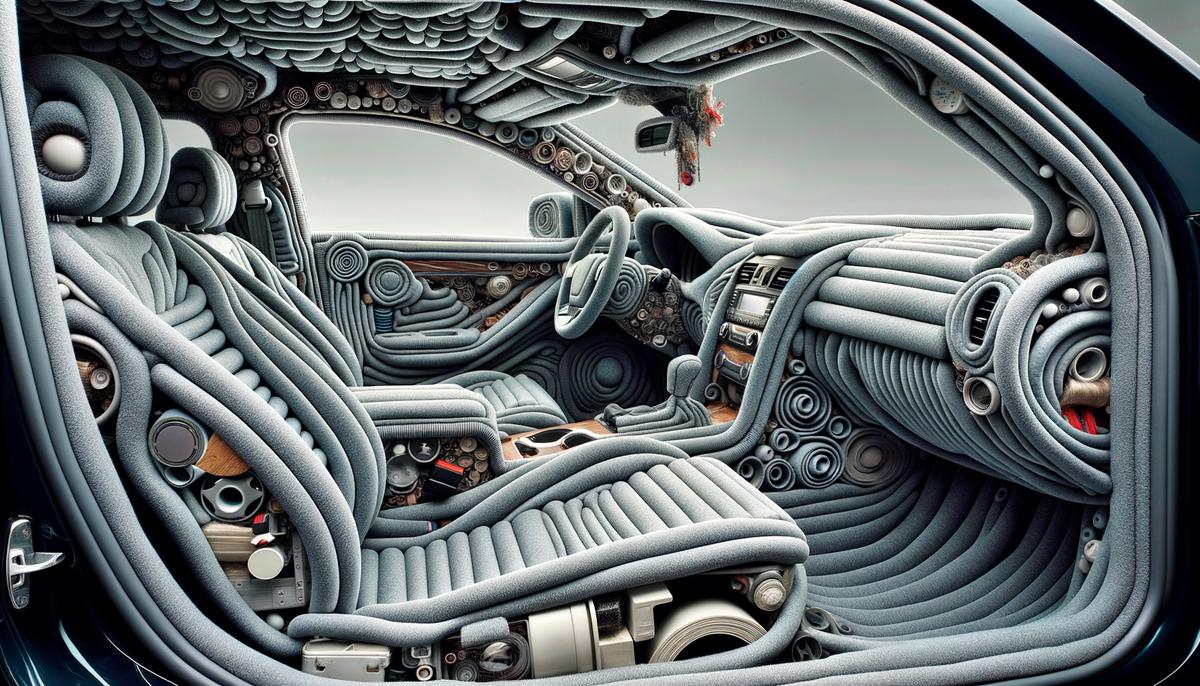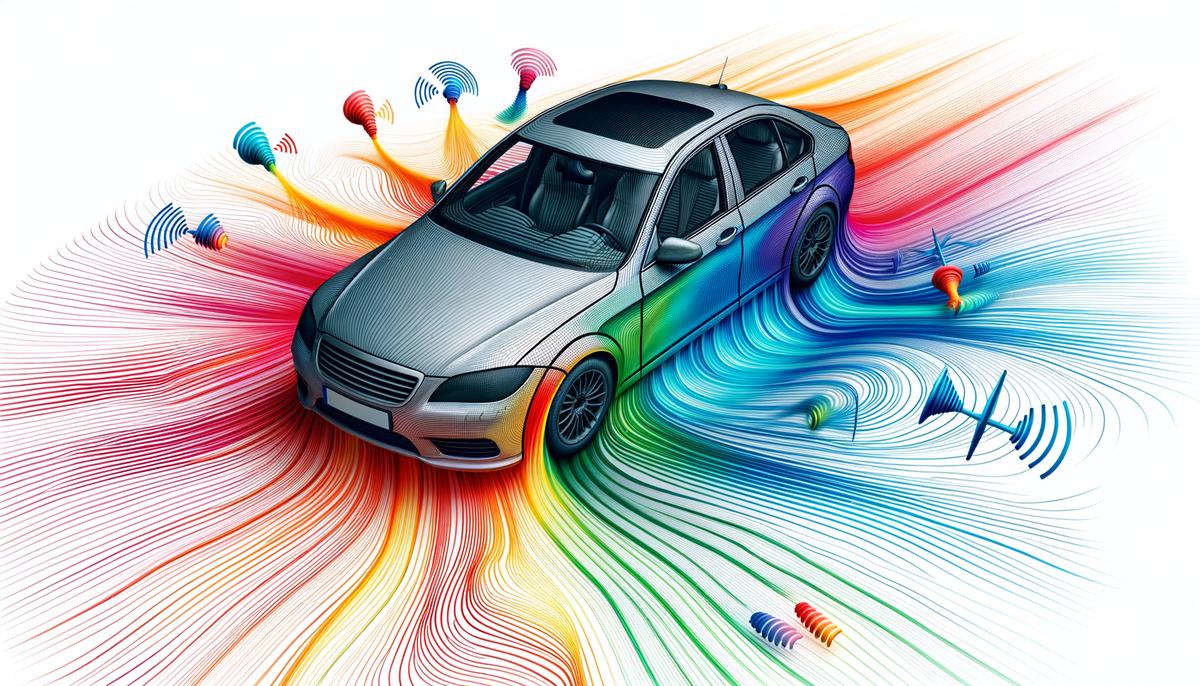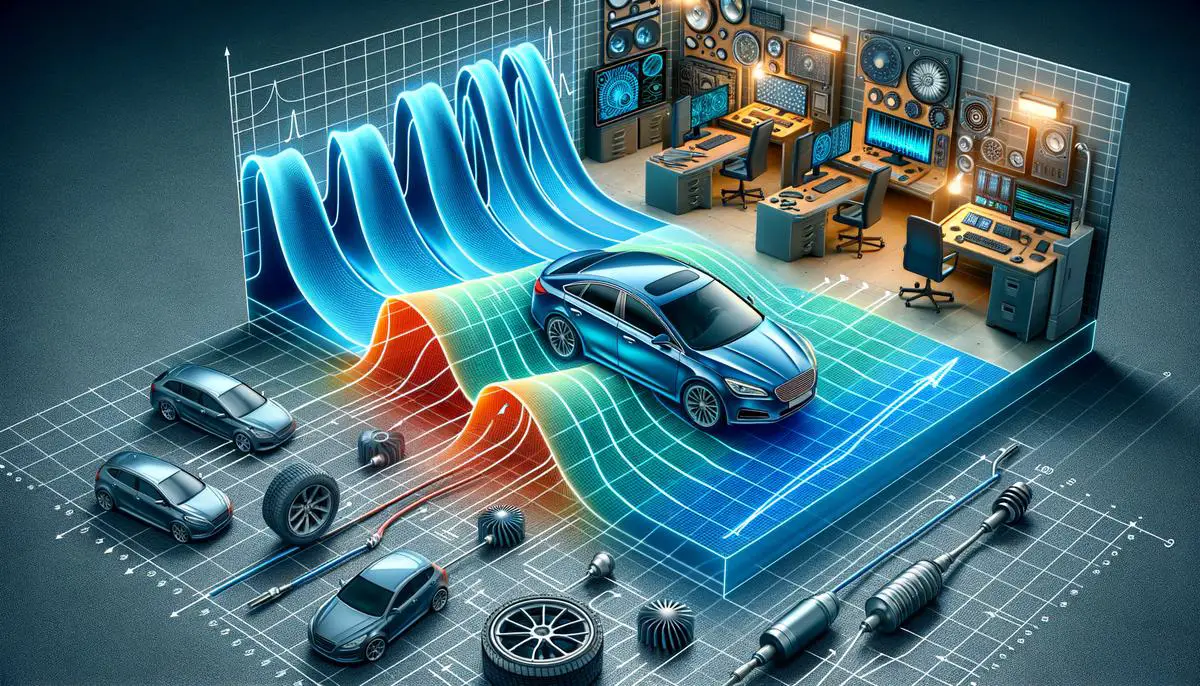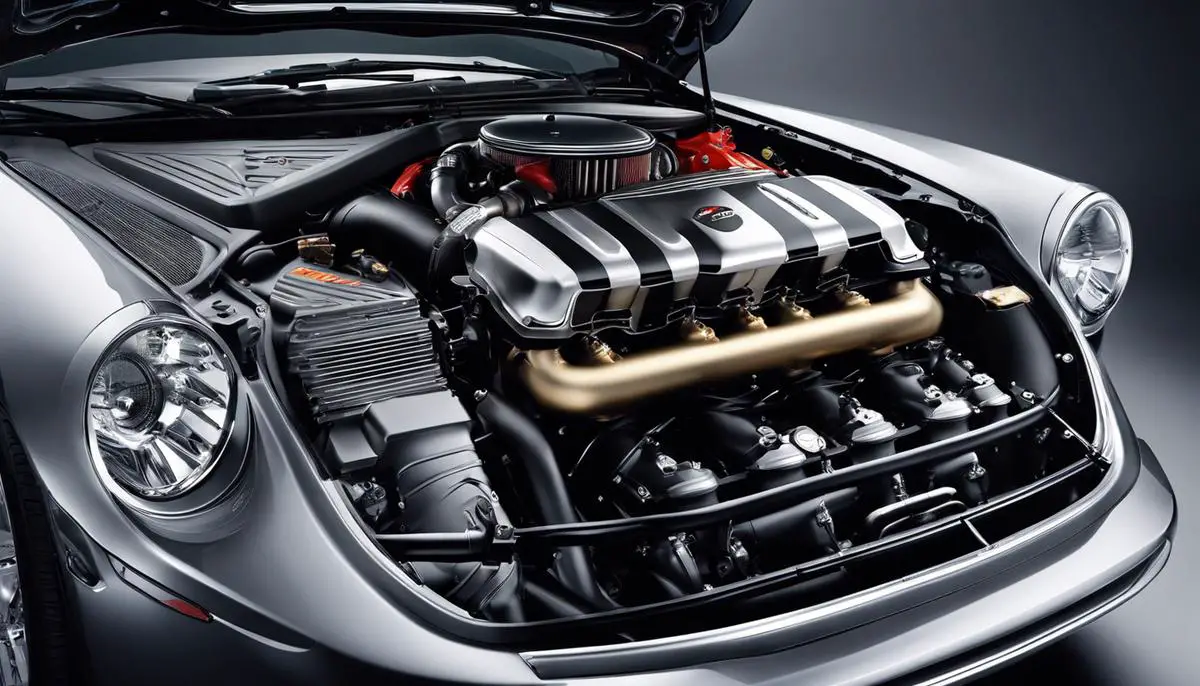When it comes to designing cars, making sure passengers have a quiet, comfortable ride is key. This takes a blend of physics, materials science, and some clever engineering to reduce the noises of the road, wind, and the car itself. From how a car is shaped to cut through the air, to the materials that soak up sound inside, every part plays a role in making the interior as quiet as it can be. Let’s look at how car designers tackle the challenge of noise and create a peaceful space inside your car.
Contents
The Physics of Sound in Automotive Design
Automotive designers employ several physics principles to minimize interior noise, making car rides quieter and more enjoyable for passengers. Understanding how sound works and interacts with materials and surfaces is fundamental in reducing unnecessary noise within a vehicle’s cabin. Let’s explore the key strategies and physics concepts that automotive designers use to achieve this objective.
Sound Absorption and Insulation
One primary method to reduce interior noise is through sound absorption and insulation. Sound waves can travel through the air and get amplified when they hit hard surfaces. To counteract this, designers use special materials within the car’s interior, such as foam and fiber insulators, which absorb sound waves rather than reflecting them. This approach effectively minimizes the echo effect within the cabin, reducing the overall noise.
Aerodynamics
The shape of the car is crucial in determining how much noise it will generate when moving. Aerodynamics, the study of how gases interact with moving objects, plays a significant role here. Automotive designers strive to create vehicle shapes that allow air to flow smoothly over the car’s surfaces. By minimizing the air resistance and turbulence around the vehicle, designers can significantly cut down on the wind noise heard inside the cabin.
Tire Design
The interaction between tires and the road surface is another significant source of interior noise. To tackle this, physics comes into play again. Tires are designed with specific tread patterns that minimize the vibration and noise generated as they roll over different surfaces. The material composition of the tires also contributes to noise reduction, with designers choosing compounds that offer a balance between grip, durability, and noise dampening.
Vehicle Body Structure
The vehicle’s body contributes to how sound is transmitted and can either amplify or dampen interior noise. Using principles of structural dynamics, designers engineer the car’s frame and body panels to reduce vibration, which, in turn, decreases the sound levels inside the car. Special attention is given to areas prone to vibration, with reinforcements added to prevent flexing that can lead to noise.
Windows and Sealing
The car’s windows and seals are potential entry points for external noise. To address this, automotive designers rely on the properties of materials and the principles of acoustics to choose the right type of glass and sealing techniques. Thicker, sometimes laminated, glass can significantly reduce the amount of noise that penetrates the cabin. Additionally, ensuring airtight seals around doors and windows prevents external sounds from entering the vehicle.
Engine and Exhaust System Design
The car’s engine and exhaust system are internal sources of noise. Here, designers work to isolate these noises or minimize their transfer to the cabin. Using mounts that absorb vibrations and materials that insulate sound within the engine bay and exhaust paths helps keep the interior quiet. The design of the exhaust system itself also aims to reduce noise while allowing the engine to breathe efficiently.
In conclusion, automotive designers use a blend of materials science, aerodynamics, structural engineering, and acoustics, all rooted in physics, to minimize interior noise. By understanding how sound behaves and interacts with the vehicle’s components, they can create quieter, more peaceful automotive experiences for passengers. The result is not just a quieter ride but also a vehicle that feels more solid and luxurious, enhancing the overall driving experience.

Materials Technology in Noise Reduction
Integrating advancements in materials technology significantly contributes to the reduction of noise in modern vehicles, ensuring a quieter and more comfortable driving experience. These innovations are not just limited to the physical barriers and absorptive materials traditionally employed but extend into sophisticated engineering designs and the application of state-of-the-art materials in key areas of automobile manufacture.
Active Noise Cancellation Technology
At the forefront of noise reduction strategies in modern cars is the utilization of active noise cancellation technology. This advanced system operates similarly to noise-cancelling headphones. It employs microphones strategically placed throughout the vehicle to pick up ambient sound. The system then generates sound waves of the opposite phase through the car’s audio system, effectively cancelling out unwanted noise such as engine, road, or wind noise. This technological solution represents a significant leap from passive noise reduction tactics, embracing digital innovation to create a serenely silent interior environment.
Advanced High-Density Materials for Enhanced Sound Insulation
Materials science has made remarkable strides in developing high-density materials that are both lightweight and effective in dampening vibrations and noise. These materials have found their way into various parts of the car, including the floor panels, doors, and even within the engine compartment. High-density foam, for instance, can be injected into hollow sections of the car’s frame, significantly reducing vibration and noise transmission without substantially increasing the vehicle’s weight. Similarly, advanced composites and polymers are being used to replace traditional metal parts, offering superior insulation against noise while contributing to the overall reduction of the car’s weight and improving fuel efficiency.
Acoustic Laminated Glass
The application of acoustic laminated glass for windshields and windows marks another noteworthy innovation in materials technology aimed at noise reduction. This type of glass comprises multiple layers; a traditional glass layer is bonded with a specialized acoustic interlayer designed to absorb and dampen sound. The result is a significant reduction in wind noise and other exterior sounds, thus enhancing the tranquility within the vehicle’s cabin. The adoption of acoustic laminated glass also reinforces the vehicle’s structural integrity and improves safety, offering additional benefits beyond noise reduction.
Refined Weatherstripping and Seals
Improvements in the materials used for weatherstripping and seals around doors, windows, and other entry points have greatly contributed to noise reduction in modern cars. Advanced rubber compounds and synthetic materials are engineered to provide a tighter and more resilient barrier against external noise. These materials are specifically designed to maintain their elasticity and effectiveness over a wide range of temperatures and conditions, ensuring consistent performance and contributing to the overall soundproofing of the vehicle.
In conclusion, the concerted application of advancements in materials technology plays a vital role in noise reduction within modern vehicles. From active noise cancellation systems to the use of high-density insulating materials, acoustic laminated glass, and refined sealing techniques, these innovations collectively contribute to a markedly quieter and more enjoyable driving experience. As research and development in materials science continue to advance, we can expect further enhancements in noise reduction technologies, making the cars of the future even quieter and more comfortable.

Active Noise Cancellation Systems
Creating a quieter vehicle interior is a significant goal in automobile design, improving both driver and passenger comfort. One of the key technologies employed to achieve this is Active Noise Cancellation (ANC). This technology plays an integral role in complementing existing sound absorption and insulation strategies by actively counteracting unwanted noise. Let’s delve into how ANC operates and its impact on vehicle interior quietness.
Active Noise Cancellation operates on the principle of sound wave interference. At its core, ANC utilizes microphones placed strategically within the vehicle’s cabin to detect unwanted ambient noise. These noises could stem from various sources, including the engine, exhaust systems, and interaction with road surfaces. Once this noise is detected, the system swiftly processes this information and generates an opposing sound wave – known as “antinoise.” This antinoise is emitted through the vehicle’s speaker system.
The magic of ANC lies in the antinoise’s ability to precisely counterbalance the original noise. When two sound waves of the same amplitude but with opposite phases meet, they interfere with each other. This interference leads to a reduction in the overall noise level within the cabin, effectively canceling out the undesirable sound. The result is a significantly quieter and more serene internal environment for occupants.
To ensure the effectiveness of Active Noise Cancellation, the system constantly monitors the cabin’s sound environment. This real-time adjustment is crucial for handling the dynamic nature of road noise and other external factors that can affect interior sound levels. Whether it’s changes in road texture, speed, or even the vehicle’s systems, ANC adapts to maintain a peaceful interior ambiance.
Moreover, ANC technology complements physical sound insulation methods. While materials with high-density and acoustic laminated glass provide a solid barrier against external noise, they can’t eliminate it entirely. ANC steps in to tackle those residual sounds that penetrate the cabin, offering an added layer of quietness.
In addition to enhancing comfort, ANC contributes to reduced driver fatigue. Continuous exposure to low-frequency noise, such as engine rumbling, can be tiring over long drives. By diminishing this type of noise, Active Noise Cancellation makes for a more pleasant and less exhausting driving experience.
In conclusion, Active Noise Cancellation technology significantly contributes to creating a quieter vehicle interior. By intelligently generating antinoise to neutralize unwanted sounds, it offers an advanced solution that works hand in hand with traditional soundproofing methods. Through this synergy, ANC elevates the quietness of the vehicle cabin to new levels, making journeys more enjoyable and comfortable for everyone inside.

The Role of Aerodynamics in Noise Reduction
Aerodynamics play a vital role in influencing noise levels inside vehicles — a concept that might not be immediately obvious.
When air moves around an object at high speed, such as a car on the highway, it doesn’t simply flow smoothly. The way air interacts with the vehicle’s surface can lead to various noises that can impact the comfort level inside the cabin.
Let’s explore how aerodynamics affect these noise levels and consider ways designers work to mitigate unwelcome sounds, ensuring a quieter ride for passengers.
Firstly, the shape of a vehicle dictates how air flows around it. Engineers spend countless hours in wind tunnels and using computational fluid dynamics to sculpt car bodies that not only reduce drag for better fuel efficiency but also minimize noise.
Airflow turbulence around areas like side mirrors, roof racks, or uneven surfaces can create whistling or whooshing sounds. As such, the smoother and more streamlined the design, the lesser the air turbulence, and consequently, the quieter the vehicle interior becomes.
Aerodynamics also influence how exterior noises enter the vehicle. For example, gaps in the car’s bodywork can act as channels that funnel wind noise directly into the cabin. This is why meticulous attention is paid to the design of door seals and window framing.
An aerodynamically optimized car will have well-sealed doors and windows, preventing air from whistling through cracks and crevices.
The vehicle’s undercarriage affects airflow and noise as well. Aerodynamic panels can be applied to the bottom of the car to smooth air passage and prevent the turbulent air from creating excessive noise. These panels not only contribute to a quieter ride but also to enhanced fuel efficiency by reducing the overall drag on the vehicle.
Furthermore, the innovation in wheel and tire design is crucial. Airflow around the tires can generate noise, especially at high speeds. Engineers work on tire tread patterns and the wheel wells to minimize this effect.
Creating a barrier between the tires and the cabin, with aerodynamic features, contributes significantly to reducing the amount of noise that penetrates the vehicle’s interior from the road.
Aeroacoustics, a branch of aerodynamics, focuses specifically on understanding and controlling the noise generated by air movement.
Through aeroacoustic studies, engineers can identify specific sources of noise and work on targeted solutions to mitigate them. This could involve introducing subtle changes in the shape of the car that might not be visible to the naked eye but have a significant impact on reducing noise levels.
In conclusion, aerodynamics is a key factor in determining how much and what kind of noise impacts vehicle occupants.
Through careful design and engineering, automakers can significantly reduce noise levels, leading to a more peaceful and enjoyable ride.
Striking the right balance between aerodynamic efficiency and noise reduction requires a deep understanding of how air interacts with a moving vehicle and a commitment to refining every aspect of the car’s design.
As technology and materials continue to advance, we can expect future vehicles to become even quieter, further enhancing the driving experience for everyone on board.

By weaving together advanced materials, cutting-edge technology, and thoughtful design, car manufacturers are able to create interiors that not only feel luxurious but are remarkably quiet as well. These efforts show how much science and engineering go into turning a vehicle into a sanctuary from the noise of the world outside. As we look ahead, the continuous advancements in these areas promise even quieter and more serene driving experiences, proving that when it comes to making cars better for everyone inside, silence really is golden.



